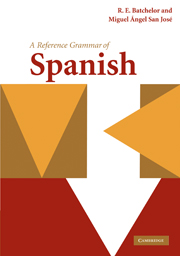Book contents
- Frontmatter
- Contents
- Preface/Prólogo
- Acknowledgments/Agradecimientos
- Abbreviations/Abreviaturas
- Introduction to the Spanish language/Introducción a la lengua española
- Part I
- 1 Register/Registro
- 2 Alphabet, spelling, pronunciation/Alfabeto, ortografía, pronunciación
- 3 Stress and accent marks/Acento tónico y acento ortográfico
- 4 Punctuation, upper case, lower case/Puntuación, mayúsculas, minúsculas
- 5 Apocopation/Apócope
- 6 Agreement/Concordancia
- Part II
- Part III
- Part IV
- Part V
- Part VI
- Part VII
- Part VIII
- Part IX
- Part X
- Appendix I Verb tables/ Tablas de verbos
- Appendix II Glossary/Glosario
- Bibliography/Bibliografía
- General index/Índice general
- Subjunctive index/Índice del subjuntivo
2 - Alphabet, spelling, pronunciation/Alfabeto, ortografía, pronunciación
from Part I
Published online by Cambridge University Press: 05 June 2012
- Frontmatter
- Contents
- Preface/Prólogo
- Acknowledgments/Agradecimientos
- Abbreviations/Abreviaturas
- Introduction to the Spanish language/Introducción a la lengua española
- Part I
- 1 Register/Registro
- 2 Alphabet, spelling, pronunciation/Alfabeto, ortografía, pronunciación
- 3 Stress and accent marks/Acento tónico y acento ortográfico
- 4 Punctuation, upper case, lower case/Puntuación, mayúsculas, minúsculas
- 5 Apocopation/Apócope
- 6 Agreement/Concordancia
- Part II
- Part III
- Part IV
- Part V
- Part VI
- Part VII
- Part VIII
- Part IX
- Part X
- Appendix I Verb tables/ Tablas de verbos
- Appendix II Glossary/Glosario
- Bibliography/Bibliografía
- General index/Índice general
- Subjunctive index/Índice del subjuntivo
Summary
The RAE, founded in 1714 by the Duque d'Escalona, aims to preserve and improve the Spanish language. Alarcos Llorach's Gramática and the Diccionario de la lengua española published by the Academy have traditionally established the standard for the language. However, it can no longer legislate for the Spanish of the Americas, where all the countries have created parallel academies that deliberate, sometimes collectively, on the development of the language (see note 2 in the introduction, p. xvii).
As far as the grammar of the various countries is concerned, there is a comforting uniformity which applies to a large extent to the alphabet. Furthermore, the spelling system of the Spanish language is really quite easy compared to English – or to French or Italian for that matter. The following tables illustrate the Spanish alphabet, which includes thirty phonemes, or sets of speech sounds. Both upper and lower cases are provided. The Spanish names for these phonemes appear in parentheses, while Argentinian, Mexican and Colombian usage is also included. It should be borne in mind that symbols or letters can help towards accurate sound reproduction, but cannot replace the sounds, intonation and stress of a native speaker.
- Type
- Chapter
- Information
- A Reference Grammar of Spanish , pp. 11 - 25Publisher: Cambridge University PressPrint publication year: 2010



